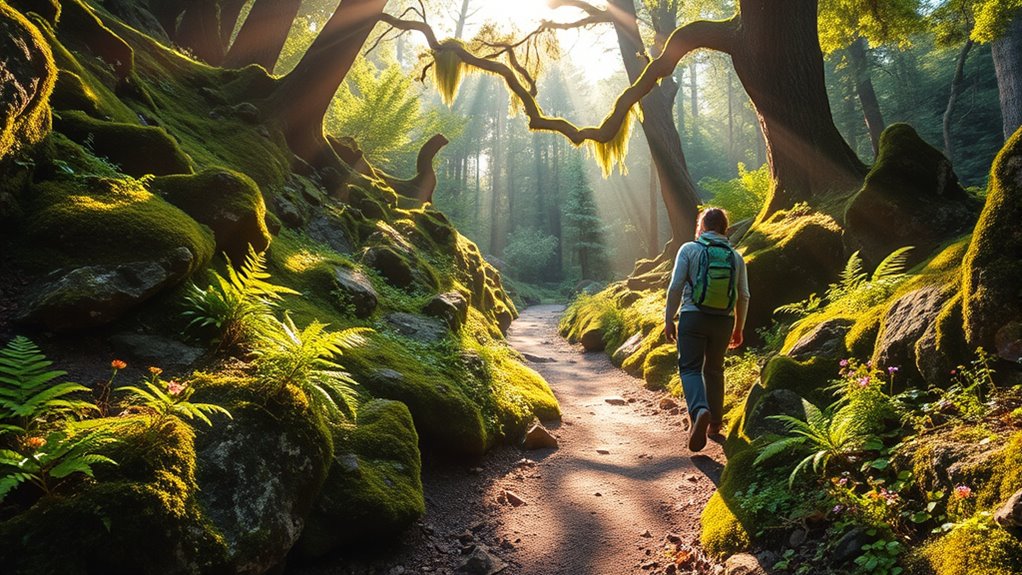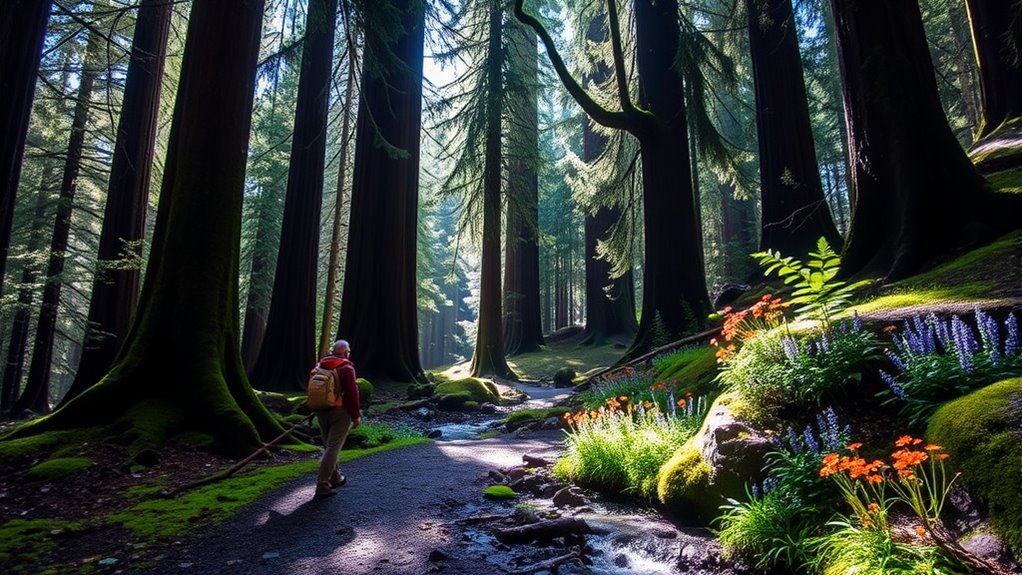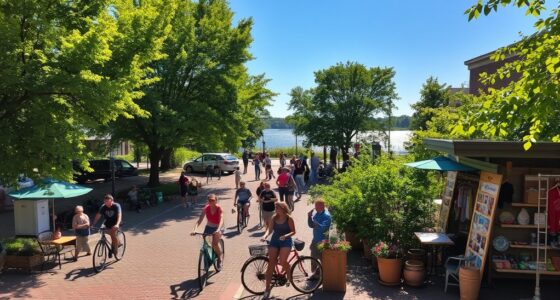Low-impact hiking in Olympic National Park is key to preserving its breathtaking landscapes and fragile ecosystems. Stick to designated trails to reduce erosion and protect native plants. Choose eco-friendly gear made from sustainable materials, and always carry out your trash to keep the area pristine. By following the Leave No Trace principles, you’ll help maintain the natural beauty for future visitors. Discover more tips and practices to enhance your hiking experience while supporting conservation efforts.
Key Takeaways
- Stick to designated trails to prevent erosion and protect native plants and wildlife in Olympic National Park.
- Choose eco-friendly gear made from sustainable materials to minimize environmental impact while hiking.
- Carry out all trash and food scraps to avoid harming wildlife and maintain park cleanliness.
- Educate fellow hikers about low-impact practices to foster a community dedicated to conservation efforts.
- Respect sensitive areas like wetlands and meadows to preserve the natural beauty of the park.

Low-impact hiking is a fantastic way to explore nature while minimizing your footprint on the environment. When you venture into Olympic National Park, you’re not just enjoying breathtaking vistas; you’re also participating in trail preservation. By practicing low-impact hiking techniques, you help protect the delicate ecosystems that make this park so special. It’s essential to tread lightly and respect the natural surroundings, guaranteeing they remain pristine for future generations.
You might be wondering how you can contribute to this mission while enjoying your hike. Start by choosing eco-friendly gear that aligns with your commitment to sustainability. Opt for lightweight, durable materials that reduce waste and energy consumption. Look for brands that prioritize ethical manufacturing practices and utilize recycled materials. By investing in high-quality gear, you not only enhance your hiking experience but also support companies that care about the environment.
Choose eco-friendly gear to enhance your hiking experience while supporting sustainability and protecting our environment.
When you’re on the trail, remember to stick to designated paths. Wandering off-trail can cause erosion and damage to native plants. By keeping to established routes, you help guarantee that the beauty of Olympic National Park is preserved. If you encounter areas that are particularly sensitive, like wetlands or meadows, keep your distance. Nature has a way of recovering when we give it the space it needs.
Another essential aspect of low-impact hiking is practicing Leave No Trace principles. Carry out what you carry in, including all trash and food scraps. These items can harm wildlife and disrupt the natural balance of the park. If you snack along the way, use reusable containers to minimize waste. Hydration is important, but instead of single-use plastic bottles, consider a refillable water bottle or hydration system. Every small choice you make can contribute to trail preservation. Additionally, being mindful of your spending while hiking can help you allocate funds towards grocery savings strategies that support sustainable practices.
While hiking, you’ll likely encounter fellow outdoor enthusiasts. Share your knowledge about eco-friendly practices and encourage others to follow suit. A collective effort can create a more substantial impact, and your actions can inspire others to adopt low-impact principles. Engage in conversations about the importance of preserving the trails and the environment, fostering a community that values sustainability.
In the end, low-impact hiking in Olympic National Park is about enjoying the journey while being mindful of the land you traverse. By using eco-friendly gear and respecting trail preservation, you’re doing your part to maintain the park’s beauty for years to come. So lace up your boots, grab your gear, and hit the trails with purpose!
Frequently Asked Questions
Are Pets Allowed on Hiking Trails in Olympic National Park?
Pets aren’t allowed on most hiking trails in Olympic National Park, so it’s best to plan accordingly. If you’re traveling with your furry friend, consider checking out designated pet areas or nearby parks. Remember to follow trail etiquette, keeping your pet leashed and cleaning up after them. Packing travel essentials like water and food for your pet can enhance your experience, ensuring you both enjoy the beauty of the outdoors safely and responsibly.
What Should I Do if I Encounter Wildlife?
When wildlife crosses your path, it’s like stumbling upon a surprise party—exciting but requires caution! For wildlife safety, stay calm and keep your distance. Observe from afar, using binoculars if needed. Don’t approach or feed animals, as this can be dangerous for both you and them. Practice observation etiquette by respecting their space and environment. If the animal seems agitated, back away slowly and quietly, ensuring a safe encounter for everyone involved.
Are There Any Guided Low-Impact Hikes Available?
Yes, there are several guided hike options available that focus on low-impact trail programs. These hikes often emphasize environmental stewardship and sustainable practices, ensuring you enjoy nature without harming it. Local organizations and park services typically offer these guided experiences, allowing you to learn from knowledgeable leaders while exploring stunning landscapes. Consider checking their schedules online or visiting visitor centers to find a hike that fits your interests and abilities.
Can I Camp Overnight While Low-Impact Hiking?
Yes, you can camp overnight while low-impact hiking, but you’ll need to follow Leave No Trace principles to minimize your environmental impact. Choose eco-friendly camping sites that allow you to set up away from trails and water sources. Pack out all waste, use biodegradable soap, and camp on durable surfaces. By doing this, you conserve nature’s beauty and ensure future hikers enjoy the same pristine experience you did. Happy camping!
What Is the Best Season for Low-Impact Hiking?
The best season for low-impact hiking is typically late spring to early fall. During this time, you’ll enjoy the most favorable trail conditions, with dry paths and vibrant scenery. Summer offers the warmest weather, but if you prefer fewer crowds, consider late spring or early fall. Just keep an eye on season timing, as it can affect trail accessibility, especially after heavy rains or snowmelt. Always check conditions before you head out!
Conclusion
By embracing low-impact hiking in Olympic National Park, you’re not just enjoying breathtaking scenery, but also protecting the delicate ecosystems that thrive here. Did you know that nearly 4 million visitors explore the park each year? By following sustainable practices like sticking to trails and minimizing waste, you can help preserve this natural wonder for future generations. So, lace up your boots, tread lightly, and remember that every small action contributes to the park’s longevity.










